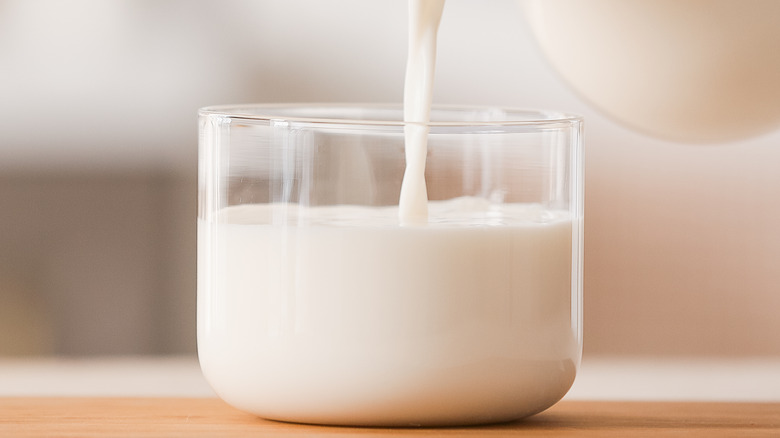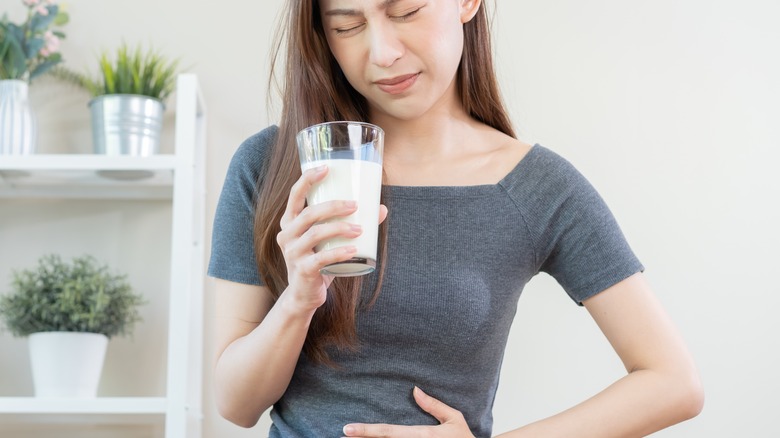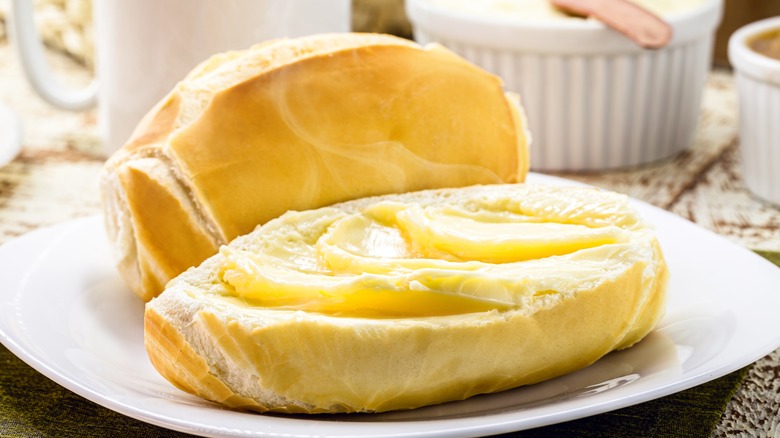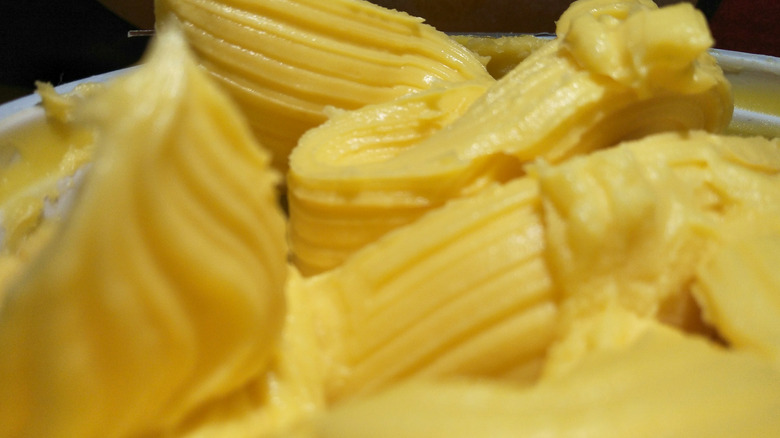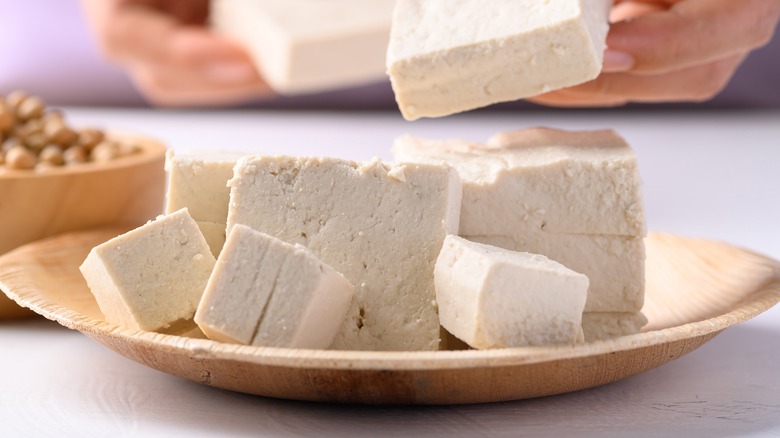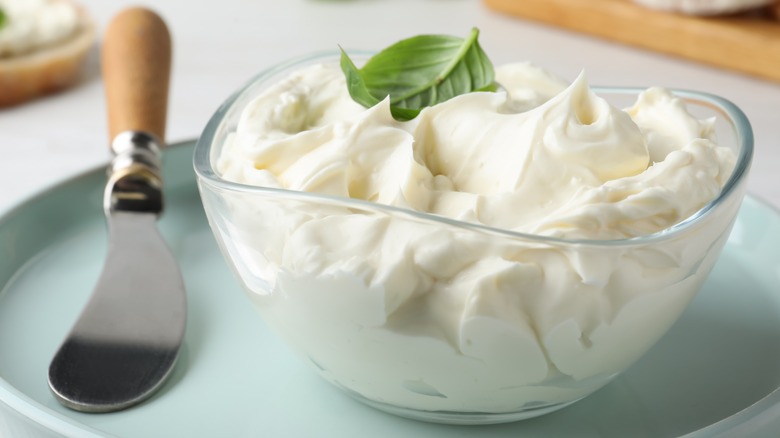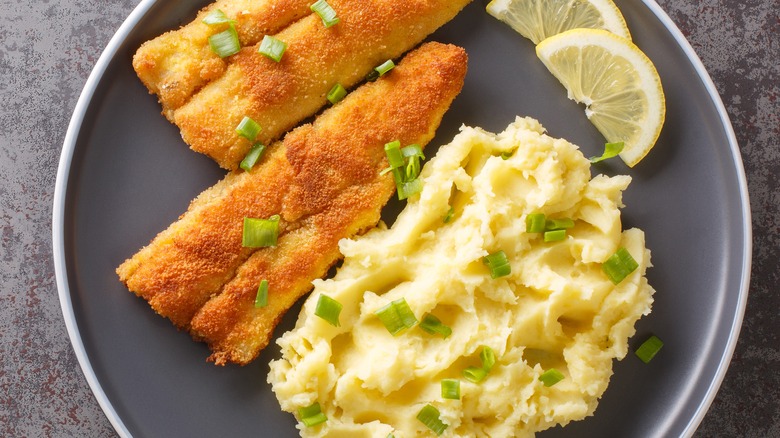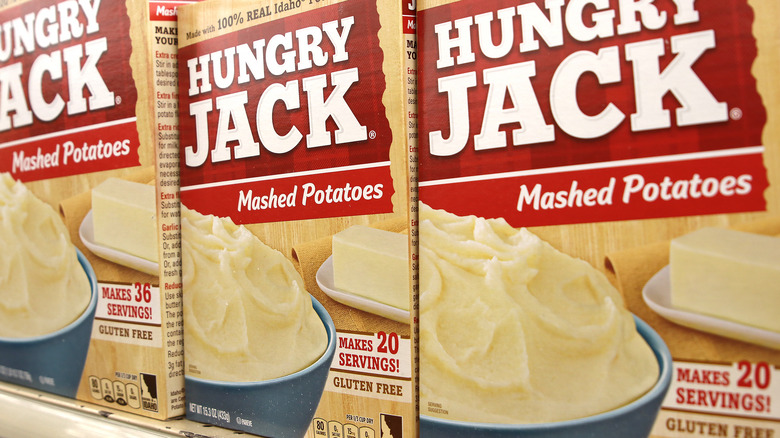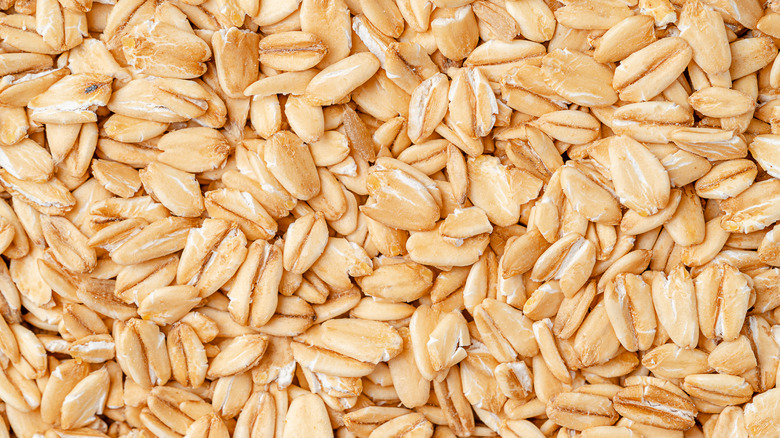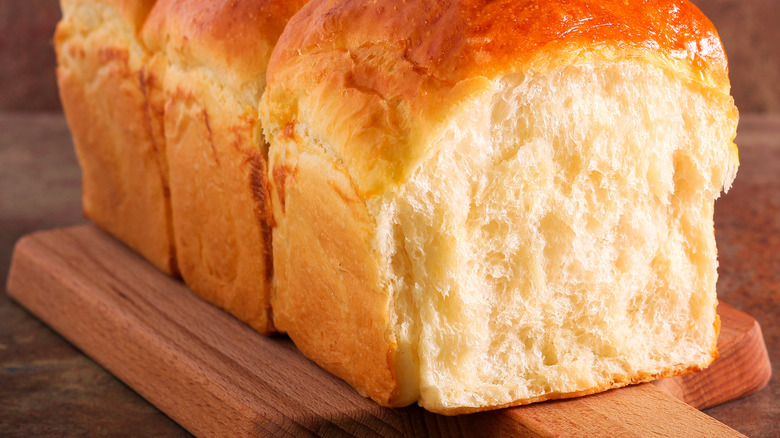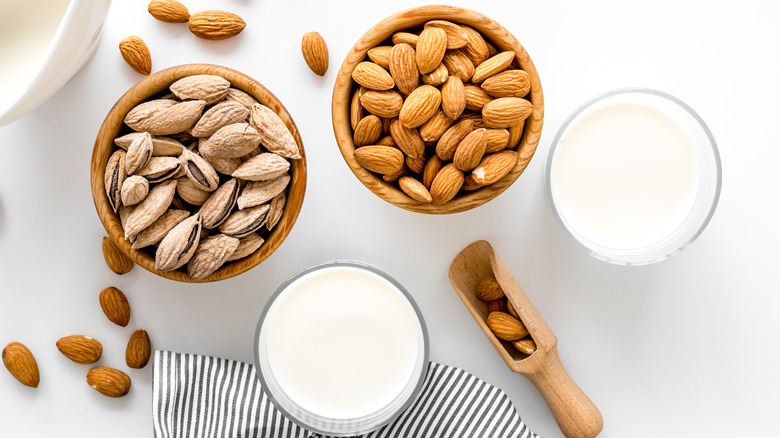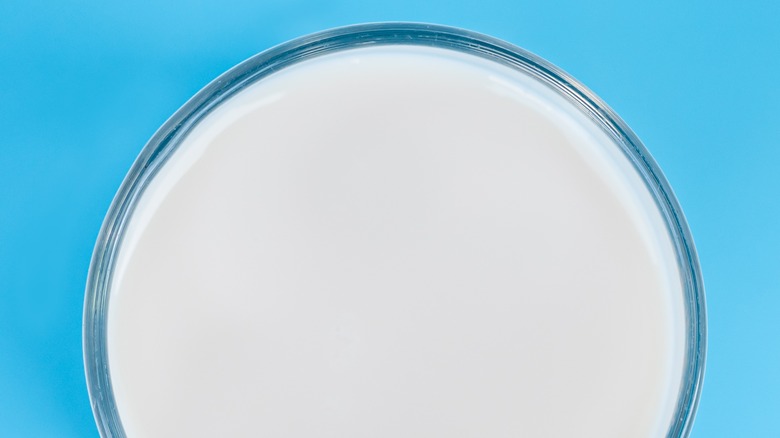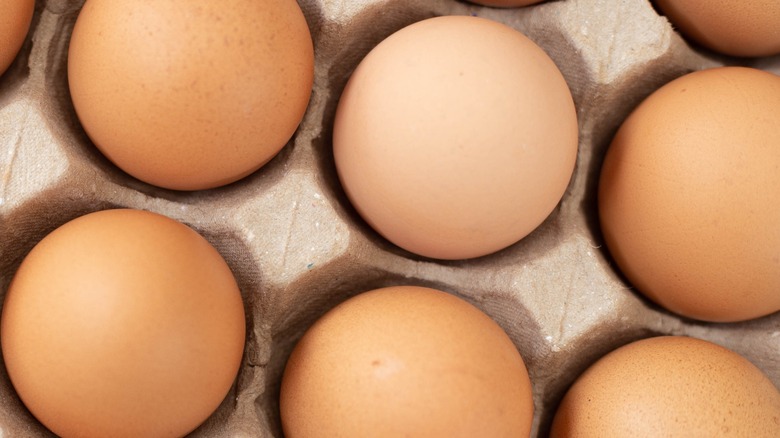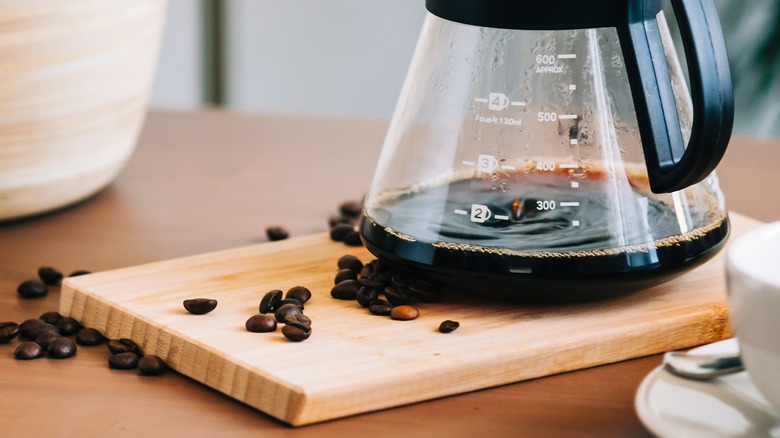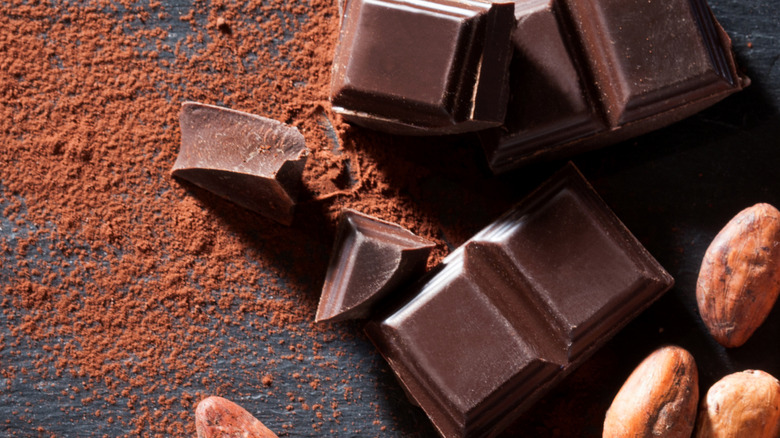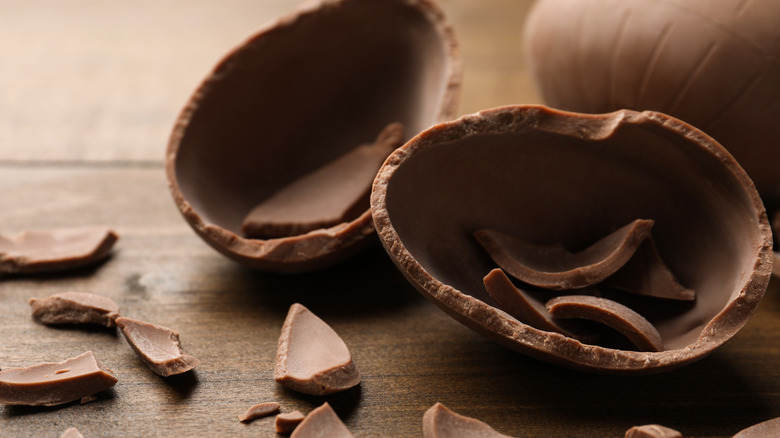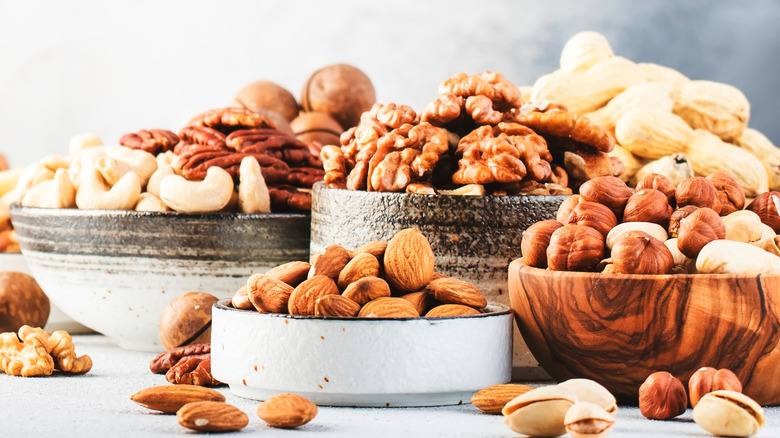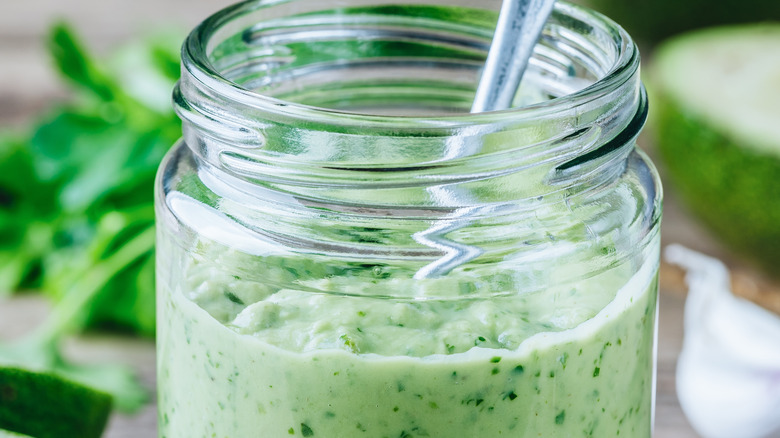9 Foods To Eat And 9 To Avoid When Following A Lactose-Free Diet
There was a time when milk reigned supreme in the American diet, and a carton of daily milk was every kid's best friend. But nowadays, things have changed. More and more people are starting to veer away from traditional cow's milk in their daily diet in favor of alternatives, and a big reason for that is an increasing awareness that the lactose in milk products might not be doing you any favors.
Lactose intolerance is far from a niche health concern: Worldwide, around 70% of all people have difficulty digesting milk sugars, according to research published in the Journal of Dairy Science. And although the rates of lactose intolerance are way higher in Asia and Africa, in the U.S., a little over one in three people are lactose intolerant to varying degrees, meaning that you may even have lactose malabsorption and not even know it (per the National Institute of Diabetes and Digestive and Kidney Diseases).
The problem, though, is that lactose is everywhere. And if you've recently decided to remove lactose from your diet, it can be tricky to know what not to eat, as well as what foods to favor. That's why we decided to put together our top foods to eat and avoid if you're going lactose-free.
How do I know if I have lactose intolerance?
If you consume a varied diet (and if so, good for you!), it can sometimes be difficult to pinpoint the specific foods that might not be agreeing with your body, and which food is causing specific symptoms. With lactose intolerance, it's useful to look out for a few telltale signs. Lactose intolerance symptoms are gastrointestinal, and generally appear within a few hours of consuming food with lactose in it, says the Mayo Clinic. You may experience gas, bloating, and stomach cramps, and on the more dramatic end of the spectrum, vomiting and diarrhea.
Consuming lactose when you're lactose intolerant won't have any long-lasting effects, but if you're noticing these symptoms, a simple test may confirm that it's wise to avoid it. A hydrogen breath test or glucose blood test may be diagnosed by your doctor, with your hydrogen or glucose levels confirming an intolerance alongside your symptoms (per MedlinePlus). Remember, too, that lactose intolerance is an entirely different condition from a dairy allergy, which may produce severe, potentially dangerous symptoms due to your body's immune response.
Eat: butter
So, we can understand why this one might raise a few eyebrows but go with us here. Butter exists in the dairy family, as food derived from cow's milk, says Healthline. But despite this, it contains very little lactose at all, and may well be tolerable for people who are trying to follow a lactose-free diet.
How does this work, you ask? It's all down to butter's production process. Butter is made by churning milk, and separating the milk and fat parts of the liquid. The fat part, which is the solid that we come to know as butter, is separated from the lactose sugars. As a result, that perfect slab of creamy yellow usually only contains tiny amounts of it. It's possible to make butter even lower in lactose by clarifying it, a process where the milk solids are entirely removed, leaving only butterfat.
It's important to bear in mind, though, that while butter is tolerable for a large amount of lactose intolerant people, for folks who are extremely sensitive to the sugars, it may still cause discomfort and difficulty. So make sure to be vigilant when you're eating it, and monitor your symptoms closely afterward.
Avoid: margarine
Margarine is well-known as a butter substitute, and as a non-dairy fat generally created from vegetable oils, it's pretty mind-boggling to think that you should avoid it if you're lactose-free. But failing to check the label before buying margarine might be a huge mistake for lactose intolerant folks, thanks to the presence of lactose in some brands (per Healthline). It's important to note the distinction between something being dairy-based and dairy-free. Although margarine isn't dairy-based, manufacturers can often put lactose or whey into their products, as well as other dairy derivatives.
The solution to this? Make sure you're constantly scrutinizing the margarine you buy for any lactose or dairy products. It also may be worth explicitly seeking out vegan kinds of margarine like Earth Balance's butter-like spread product, which is lactose-free, vegan, MSG-free, and devoid of trans fats. Smart Balance Light or Blue Bonnet Light Margarine are also great vegan options. Or you might even want to try other plant-based spreads like coconut butter, although be aware that the flavor will differ slightly from classic margarine.
Eat: tofu
When you're trying to avoid lactose, you'll quickly find that certain sources of protein are suddenly off the menu, with milk and many types of cheese suddenly becoming no-go zones. This is where tofu can come to the rescue. With its naturally creamy texture and versatility of firmness, not only is tofu a great substitute for meat in a huge range of dishes thanks to its high-protein nature, but softer versions may even emulate cream and cheese in dishes.
But that's not the only reason why you should be trying to sneak as much tofu into your diet as possible. The soybean-derived protein is a nutritional champ, packed with antioxidants called isoflavones that may assist in minimizing free radical damage and reducing menopausal symptoms, says BBC Good Food. Isoflavones may also help to lower your levels of low-density cholesterol (or "bad" cholesterol), lessening your risk of developing cardiovascular disease. And if that weren't enough, isoflavones have also been found to be potentially beneficial in controlling blood sugar, according to research published in the Journal of Women's Health. If those aren't enough reasons to pick up a block of tofu at the store, we don't know what else to say.
Avoid: cream cheese
The indulgent, rich texture and taste of cream cheese is many people's idea of heaven. But if you have lactose intolerance, it may not surprise you to hear that cream cheese is best left off the menu.
As its name suggests, cream cheese is created using cream, a milk product that contains higher levels of lactose, as WebMD states. This is also the case for many other kinds of cheese out there, which contain lactose and should best be avoided if you have difficulty digesting it — although it should be noted that certain hard cheeses (like cheddar or parmesan) and softer varieties (like cottage cheese) may be lower in lactose and tolerable to some people.
If you're craving that distinctive cream cheese texture, however, never fear: Tofu is coming to the rescue. You can make a pretty convincing cream cheese substitute by throwing extra-firm silken tofu into a blender with oil, miso, vinegar, lemon juice, and a little salt, says GoDairyFree. Blitz the ingredients until super-smooth, transfer the cream cheese-like mixture to a tub or container, refrigerate for several hours until it's fully set, and then smother it onto a slice of toast.
Eat: mashed potatoes
There are few foods out there that are more comforting than mashed potatoes. But all too often, mashed potatoes get a bad rep for their standing as maybe not being the healthiest food in the world — and the fact that, as food that typically has glugs of milk or cream added to it, it may not be the best choice for lactose intolerant people.
Well, we're here to put a stop to that. In their base form, potatoes have some tremendous health benefits, as WebMD notes. These tasty tubers have enviable levels of fiber and resistant starch, which boosts your gut health, works to maintain healthy blood sugar, and helps to control appetite. And if that isn't enough to convince you to whip the potato masher out, they're also packed full of vitamins, minerals, and antioxidants, with high amounts of vitamin C, potassium, and vitamin B6.
And who says that you can only enjoy mashed potatoes if they're drowned in dairy? By using a combination of vegan butter-like spread, a dairy-free milk substitute like almond or soy milk, and unsweetened coconut yogurt, you're able to create a lactose-free mashed potato dish that your friends will be begging for the recipe of (per Simply Whisked).
Avoid: instant mashed potato mix
You would be forgiven for thinking that if you're trying to follow a lactose-free diet, that instant mashed potato mix might be safe. After all, instant mashed potato mix is surely just potatoes. Right?
Well, unfortunately, folks, this is one food product that may well be off-limits, thanks to the (frankly pretty weird) potential addition of lactose to instant potato mixes, as Healthline notes. This might not come as a surprise for instant mashed potato mixtures that are branded as "buttery" or "cheesy," but milk products even show up in mashed potato mixes without a lactose-based flavor profile. Idahoan Roasted Garlic Mashed Potatoes, for example, features buttermilk powder, nonfat dry milk, and whey on its ingredients list, which is also eyebrow-raisingly extensive for a simple potato dish (per Walmart).
So why do food manufacturers put lactose in non-dairy-based food products? It all comes down to texture and flavor, with lactose serving to make foods taste and feel creamier, per the experts at Gastroenterology HealthCare Associates. In the case of instant mashed potato mix, lactose also makes it easier for the mix to combine with liquids added, delivering silky-smooth mashed potatoes quicker.
Eat: oats
We've got a lot of love for the humble oat. These little guys, flake for flake, deliver more nutritional benefit than they have any business doing, and they do it without any fuss — and crucially, without any lactose involved.
Let's just take a look at how beneficial eating oats regularly could be for your health: As well as being filling and delicious, the beta-glucan fiber in oats may help to boost the healthy bacteria in your gut, control blood glucose and insulin, and keep your cholesterol in check, says Healthline. They're also loaded with valuable vitamins and minerals, including over 60% of your recommended daily value of manganese, and potent antioxidants that could assist in lowering blood pressure.
But the question remains: How do you eat oats when there's no lactose involved? Surely, oatmeal depends on a whopping great splash of milk to make it as delicious as it can be, right? Not when there are milk alternatives involved, says WebMD. Using almond milk, rice milk, soy milk, or even lactose-free cow's milk to whip up a bowl of oatmeal will give you the same creamy texture, without any of the potentially problematic lactose to contend with.
Avoid: bread
On the surface of things, bread doesn't come across as one of the main culprits of issues for people with lactose intolerance. And we get it: With flour and water as its base ingredients, bread having lactose in it might have people scratching their heads.
But unfortunately, many types of store-bought bread are abundant in lactose, according to Lactose Free 101. And one of the biggest offenders is that everyday loaf you buy to make your sandwiches with. The processing that these bread products undergo can result in dairy products like milk powder, whey, and casein being added to them. It's not just white bread where this happens, either: Whole-grain loaves of bread may have whey added to them to improve texture, flavor, and mouthfeel, and to emulate and replace lost gluten, according to Prepared Foods.
Other types of bread that might include lactose in their recipes include flatbreads, bagels, and pizza crusts. Certain pastries or sweet baked goods, like croissants or biscuits, may also have lactose in them. And as for breadcrumbs? You guessed it, folks — many breadcrumb varieties can have lactose-containing ingredients in them, with Panko breadcrumbs being a notable exception.
Eat: almond milk
Gone are the days where, if you were trying not to consume lactose, milk was off the menu. In this modern world, there are more lactose-free milks and milk alternatives than ever before, and few of them stack up as well as almond milk.
Made, as you might expect, from almonds, this milk is much lighter than regular cow's milk, with less fat, carbohydrates, and calories (as well as lower protein levels, says Healthline). Notably, almond milk is also a terrific source of vitamin E, a crucial vitamin needed to support the immune system and eye and skin health (via the NHS).
Almond milk also has a gently sweet flavor, making it an ideal choice in drinks and in recipes that require a boost of sweetness. If almonds aren't your thing, though, you won't want for other lactose-free milk alternatives. Between oat milk, rice milk, cashew milk, and soy milk, there's a wide range of lactose-free varieties out there that can capably take the place of the regular stuff. Lactose-free cow's milk is also increasingly available in stores across the land, made by adding lactase to regular milk which enables it to be more easily digested (per Healthline).
Avoid: milk
Okay, so we know this one might not be the biggest shock in the world, but it wouldn't be a very reliable list if we didn't put it on here.
Of all the foods you should be avoiding if you're trying to follow a lactose-free diet, milk is number one. Milk is full of lactose, as the NHS says, which is the type of sugar that causes so much digestive trouble in countless people. It's not just cow's milk that has lactose in it, either. Other types of animal milk, like sheep's milk and goat's milk, also contain lactose and are therefore unsuitable for anyone who's lactose intolerant.
That said, lactose intolerance can vary in severity from person to person, and while milk may be a trigger for you, it may still be tolerable in smaller amounts. A splash in your coffee or tea, for example, might not create too many problems, and minor amounts of milk in foods could also be okay to eat. Avoiding drinking milk on an empty stomach may also reduce symptom severity. The crucial thing to do is to listen closely to your body and its signals and respond accordingly.
Eat: eggs
Eggs are frequently described as being part of the dairy family, and given that they appear alongside milk and butter in countless recipes, it's easy to understand why. But we're here to put an end to misinformation once and for all: Eggs are not dairy, and by that same token, are perfectly safe to eat if you're trying to avoid lactose. The distinction all lies in the definitions of the two: Dairy refers to foods that are made using milk from mammals (like cheese, cream, etc.), whereas eggs are laid by birds, as Healthline clarifies.
As a result of this, eggs have no lactose at all in them. For people with lactose intolerance, they're a great choice, particularly as they offer a source of proteins and fats that you might lose if you're removing milk products from your diet. Importantly, though, remember that while eggs in themselves are lactose-free, egg dishes and premade egg mixes may well have lactose-containing products added to them, so make sure you're double-checking before you eat.
Avoid: sausages
Forgive us for being old-fashioned here, but we don't really expect our meat to have lactose in it. We kinda expect our meat to be made of ... well, meat. But in the case of processed meats like sausages, lactose may be lurking inside the casing without you even realizing it. Processed meats may have dairy derivatives like lactose or casein added during their production process (via McLean Meats). Lunch meats and deli meats may also undergo the same process, making them off-limits for folks trying to avoid lactose.
The good news is that you don't have to avoid sausages entirely; you just have to be careful about which types you're buying. One handy trick is to look for products labeled "kosher." The kosher preparation process stipulates that dairy and meat must be treated with distinction and not prepared alongside each other, making kosher meat products safely dairy-free, says Healthline. If you can't find a kosher variety, check the food label of the sausages you're buying carefully, looking not only for lactose, but also for milk or milk-derived products like caseinate, casein, or whey.
Eat: brewed coffee
For a lot of people, a strong cup of coffee is the only way to start the day, but if you're trying to avoid lactose, the thought of not adding a splash of milk might cause you to look elsewhere. Well, we say that coffee should still firmly be in your diet, even if you end up taking it black.
It's sometimes easy to forget that coffee is a virtual nutritional superhero, not least for its potential to lower the risk of several chronic conditions, as Johns Hopkins Medicine discusses. In addition to reducing the risk of heart failure, drinking brewed coffee daily could also see your chances of developing stroke, colon cancer, and age-related diseases like Alzheimer's and Parkinson's drop.
Additionally, coffee could be your liver's best friend. A study published in BMC Public Health interrogated the effects of drinking coffee on the outcomes of chronic liver disease. Incredibly, it was found that by drinking coffee regularly (no matter what type of coffee was drunk, with instant, ground, and decaffeinated coffee all examined), the risk of developing chronic liver disease was lower. And if you can't bear the taste of black coffee? Grab yourself a milk alternative, or use lactose-free cow's milk.
Avoid: instant coffee
It might seem like instant coffee is the last place you'd find lactose. After all, how can those dark little grounds have anything made from milk in them? Unfortunately, though, the very thing that makes instant coffee so instant is also the very thing that people with lactose intolerance should avoid. "With an instant drink or product you want to stir it quickly with hot water and have it dissolve without any lumps," says registered dietitian Desiree Nielsen to Reader's Digest. "Lactose will give you that texture," Nielsen states, with the milk sugars helping to create a smooth drink.
Lactose also supplies instant coffee with an additional depth of flavor. Additionally, it's not unheard of for lactose to show up in other instant products like soups. If the thought of giving up your daily instant coffee is filling you with dread, though, never fear: Simply look out for dairy-free instant coffee options. You don't even have to give up your creamer, with brands like Califia Farms and Vital Proteins offering creamers that are delicious and fortifying (per Women's Health Magazine).
Eat: Lactose-free dark chocolate
Of all the things that you might find hard to give up when going lactose-free, chocolate might be the most heartbreaking. But we have news for you, folks: You can still get your chocolate fix on a diet without lactose. It all depends on which type of chocolate you go for, with extra-dark chocolate sometimes containing very little or no lactose, says Livestrong. There are also dairy-free dark chocolates out there, which should have no lactose in them (and are therefore safe to enjoy).
However, if you have serious lactose intolerance, it's highly important to be prudent. A survey conducted by the FDA found, rather troublingly, that certain dark chocolate products labeled as "dairy-free" actually did have milk in them, presenting not only a problem for people who are lactose intolerant, but also a serious risk for folks with a milk allergy. As such, if you're at all worried about the validity of "dairy-free" statements on chocolate products, it might be useful to get in touch with the manufacturer to inquire exactly how the product's made and if there's any risk of cross-contamination (per the FDA). Be sure to check the labels of any chocolate you're buying (even if it's extra-dark) to see if there are any milk products present, too.
Avoid: milk chocolate
There's a reason why milk chocolate is so popular: Simply put, it's delicious. But regrettably, the very thing that makes it so tasty is also the thing that takes it off the menu for people trying to stay lactose-free.
Milk chocolate is made, as you might expect, by adding milk products and higher amounts of sugar to dark chocolate (via BBC Good Food). Whether it's through milk powder, condensed milk, or boiled milk, once the dairy product enters the mix, your chocolate bar is flooded with lactose.
And for white chocolate, it's a similar deal: Milk powder is generally mixed with cacao butter and sugar to create the ultra-creamy treat, says GoDairyFree. So what's a person to do to get their chocolate fix, if they're trying to avoid lactose? Well luckily, it's the 21st century, and food experts have cracked it. As well as seeking out vegan chocolate bars (which are made with alternative ingredients like soymilk powder and dairy-free coconut milk), you could give your inner chocolatier a spin and make your very own bar! Fortunately, you don't need many ingredients, although you will need a lot of patience (and probably some trial and error). Check out this Addicted to Dates recipe, which uses dairy-free coconut milk powder and vanilla pods to create a perfect vegan chocolatey delight.
Eat: nuts
One of the biggest heartbreaks of giving up lactose in your diet means that you're saying goodbye to a lot of pleasing textures: Cheese, ice cream, and milk all take a backseat. So if you're craving something creamier while remaining dairy-free, we recommend stocking up on nuts, not least because they're super good for you.
While it's true that nuts are on the fattier side, these fats are of the unsaturated variety, says WebMD. And these unsaturated fats are ones that your body will thank you for, with the regular consumption of monounsaturated and polyunsaturated fats helping to manage inflammation and cholesterol and support heart health (per the Harvard T.H. Chan School of Public Health).
What's more, nuts are well-stocked with useful vitamins and minerals, including vitamin E, magnesium, potassium, calcium, phosphorus, and folic acids. Their higher fat content will also keep you fuller for longer, making them the perfect snack to fall back on. Best of all, nuts can be used as a substitute for dairy products; you can easily whip up a basic cashew cream at home, for example.
Avoid: (some) salad dressing
The beauty of a salad is that you can add or keep out anything you like, and so logically, it should be pretty easy to keep them lactose-free. Until you put on that bottled salad dressing, that is. Unfortunately, a large number of salad dressings have dairy and lactose products in them, with creamier salad dressings, as you might expect, being full of the stuff (per One Green Planet).
Luckily, your options for salad dressing are as wide as what you have to choose from to put in your salad itself, and there are plenty of ways to keep dairy away from your bowl. Try making a simple vinaigrette of oil, lemon juice, salt, and pepper, to give your salad a zingy, springtime taste. If you still want something creamier, though, we've got you covered. Make your very own vegan Green Goddess dressing, substituting the traditional sour cream and buttermilk for coconut milk, avocado, and tahini, as Cotter Crunch does. You can even make a vegan Caesar dressing, using hummus in place of other creamy components (per Minimalist Baker). Don't let the lack of lactose ruin your fun!

